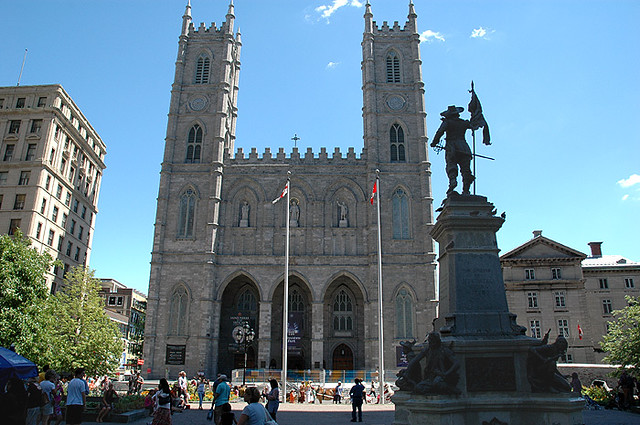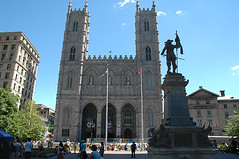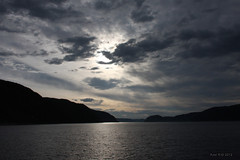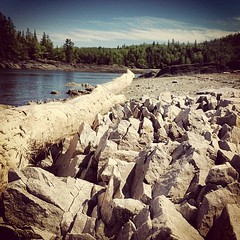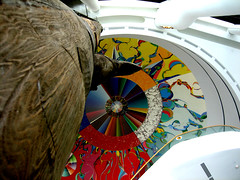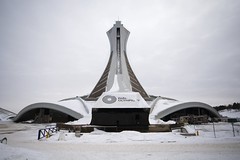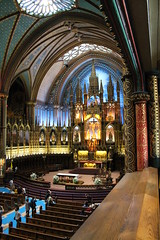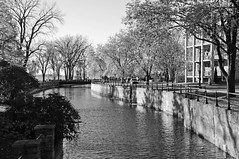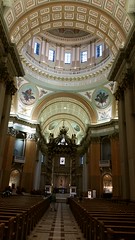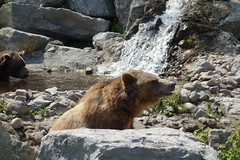Quebec
Quebec (English: /k(w)ɪˈbɛk/ ; French: [kebɛk]) is one of the thirteen provinces and territories of Canada. It is the largest province by area and the second-largest by population. Much of the population of Quebec lives in urban areas along the St. Lawrence River, between its most populous city, Montreal, and the provincial capital, Quebec City. The province is the home of the Québécois nation. Located in Central Canada, the province shares land borders with Ontario to the west, Newfoundland and Labrador to the northeast, New Brunswick to the southeast, and a coastal border with Nunavut; in the south it borders Maine, New Hampshire, Vermont, and New York in the United States.
Between 1534 and 1763, Quebec was called Canada and was the most developed colony in New France. Following the Seven Years' War, Quebec became a British colony: first as the Province of Quebec (1763–1791), then Lower Canada (1791–1841), and lastly Canada East (1841–1867), as a result of the Lower Canada Rebellion. It was confederated with Ontario, Nova Scotia, and New Brunswick in 1867, beginning the Dominion of Canada. Until the early 1960s, the Catholic Church played a large role in the social and cultural institutions in Quebec. However, the Quiet Revolution of the 1960s to 1980s increased the role of the Government of Quebec in l'État québécois (the state of Quebec).
The Government of Quebec functions within the context of a Westminster system and is both a liberal democracy and a constitutional monarchy. The Premier of Quebec, presently François Legault, acts as head of government. Québécois political culture mostly differs on a nationalist-vs-federalist continuum, rather than a left-vs-right continuum. Independence debates have played a large role in politics. Quebec society's cohesion and specificity is based on three of its unique statutory documents: the Quebec Charter of Human Rights and Freedoms, the Charter of the French Language, and the Civil Code of Quebec. Furthermore, unlike elsewhere in Canada, law in Quebec is mixed: private law is exercised under a civil-law system, while public law is exercised under a common-law system.
Quebec's official language is French; Québécois French is the regional variety. The economy of Quebec is mainly supported by its large service sector and varied industrial sector. For exports, it leans on the key industries of aeronautics, hydroelectricity, mining, pharmaceuticals, aluminum, wood, and paper. Quebec is well known for producing maple syrup, for its comedy, and for making hockey one of the most popular sports in Canada. It is also renowned for its culture; the province produces literature, music, films, TV shows, festivals, folklore, and more.
Etymology
The name Québec comes from an Algonquin word meaning 'narrow passage' or 'strait'. The name originally referred to the area around Quebec City where the Saint Lawrence River narrows to a cliff-lined gap. Early variations in the spelling included Québecq and Kébec. French explorer Samuel de Champlain chose the name Québec in 1608 for the colonial outpost he would use as the administrative seat for New France.
History
Indigenous peoples and European expeditions (pre-1608)
The Paleo-Indians theorized to have migrated from Asia to America between 20,000 and 14,000 years ago, were the first people to establish themselves on the lands of Quebec, arriving there after the Laurentide Ice Sheet melted roughly 11,000 years ago. From them, many ethnocultural groups emerged. At the time of the European explorations of the 1500s, there were eleven Indigenous peoples: the Inuit and ten First Nations the Abenakis, Algonquins (or Anichinabés), Atikamekw, Cree, Huron-Wyandot, Maliseet (also known as Wolastoqiyik or Etchemin), Miꞌkmaqs, Iroquois, Innu (or Montagnais) and Naskapis. At the time, Algonquians organized into seven political entities and lived nomadic lives based on hunting, gathering, and fishing. Inuit, on the other hand, fished and hunted whales and seals along the coasts of Hudson and Ungava Bays.
In the 15th century, the Byzantine Empire fell, prompting Western Europeans to search for new sea routes to the Far East. Around 1522–1523, Giovanni da Verrazzano persuaded King Francis I of France to commission an expedition to find a western route to Cathay (China) via a Northwest Passage. Though this expedition was unsuccessful, it established the name New France for northeastern North America. In his first expedition ordered from the Kingdom of France, Jacques Cartier became the first European explorer to discover and map Quebec when he landed in Gaspé on July 24, 1534. The second expedition, in 1535, included three ships: the , the and the . That year, Jacques Cartier explored the lands of Stadacona and named the village and its surrounding territories Canada (from , 'village' in Iroquois). After wintering in Stadacona, Cartier returned to France with about 10 St. Lawrence Iroquoians, including Chief Donnacona. In 1540, Donnacona told the legend of the Kingdom of Saguenay to the King of France. This inspired the king to order a third expedition, this time led by Jean-François de La Rocque de Roberval; it was unsuccessful in its goal of finding the kingdom.
After these expeditions, France mostly abandoned North America for 50 years because of its financial crisis; France was involved in the Italian Wars and there were religious wars between Protestants and Catholics. Around 1580, the rise of the fur trade (particularly the demand for beaver pelts) reignited French interest; New France became a colonial trading post. In 1603, Samuel de Champlain travelled to the Saint Lawrence River and, on Pointe Saint-Mathieu, established a defence pact with the Innu, Maliseet and Micmacs, that would be "a decisive factor in the maintenance of a French colonial enterprise in America despite an enormous numerical disadvantage vis-à-vis the British". Thus also began French military support to the Algonquian and Huron peoples against Iroquois attacks; these became known as the Iroquois Wars and lasted from the early 1600s to the early 1700s.
New France (1608–1763)
In 1608, Samuel de Champlain returned to the region as head of an exploration party. On July 3, 1608, with the support of King Henry IV, he founded the Habitation de Québec (now Quebec City) and made it the capital of New France and its regions (which, at the time, were Acadia, Canada and Plaisance in Newfoundland). The settlement was built as a permanent fur trading outpost, where First Nations traded their furs for French goods, such as metal objects, guns, alcohol, and clothing. Several missionary groups arrived in New France after the founding of Quebec City, like the Recollects in 1615, the Jesuits in 1625 and the Supliciens in 1657. Coureurs des bois and Catholic missionaries used river canoes to explore the interior of the North American continent and establish fur trading forts.
The Compagnie des Cent-Associés, which had been granted a royal mandate to manage New France in 1627, introduced the Custom of Paris and the seigneurial system, and forbade settlement in New France by anyone other than Roman Catholics. In 1629, Quebec City surrendered, without battle, to English privateers led by David Kirke during the Anglo-French War; in 1632, the English king agreed to return it with the Treaty of Saint-Germain-en-Laye. Trois-Rivières was founded at Samuel de Champlain's request in 1634. Paul de Chomedey de Maisonneuve founded Ville-Marie (now Montreal) in 1642.
In 1663, the Company of New France ceded Canada to King Louis XIV, who officially made New France into a royal province of France. New France was now a true colony administered by the Sovereign Council of New France from Quebec City. A governor-general, assisted by the intendant of New France and the bishop of Quebec City, governed Canada and its administrative dependencies: Acadia, Louisiana and Plaisance. The French settlers were mostly farmers and were known as "Canadiens" or "Habitants". Though there was little immigration, the colony still grew because of the Habitants' high birth rates. In 1665, the Carignan-Salières regiment developed the string of fortifications known as the "Valley of Forts" to protect against Iroquois invasions and brought along with them 1,200 new men. To redress the severe gender imbalance and boost population growth, King Louis XIV sponsored the passage of approximately 800 young French women (King's Daughters) to the colony. In 1666, intendant Jean Talon organized the first census and counted 3,215 Habitants. Talon also enacted policies to diversify agriculture and encourage births, which, in 1672, had increased the population to 6,700.
New France's territory grew to extend from Hudson Bay all the way to the Gulf of Mexico, and would also encompass the Great Lakes. In the early 1700s, Governor Callières concluded the Great Peace of Montreal, which not only confirmed the alliance between the Algonquian and New France, but also definitively ended the Iroquois Wars. From 1688 onwards, the fierce competition between the French and British to control North America's interior and monopolize the fur trade pitted New France and its Indigenous allies against the Iroquois and English in a series of four successive wars called the French and Indian Wars by Americans, and the Intercolonial Wars in Quebec. The first three of these wars were King William's War (1688–1697), Queen Anne's War (1702–1713), and King George's War (1744–1748). In 1690, the Battle of Quebec became the first time Quebec City's defences were tested. In 1713, following the Peace of Utrecht, the Duke of Orléans ceded Acadia and Plaisance Bay to Great Britain, but retained Île Saint-Jean (Prince Edward Island), and Île-Royale (Cape Breton Island) where the Fortress of Louisbourg was subsequently erected. These losses were significant since Plaisance Bay was the primary communication route between New France and France, and Acadia contained 5,000 Acad…
Looking for places related to Quebec?
Those are other destinations to find places related to Quebec:
